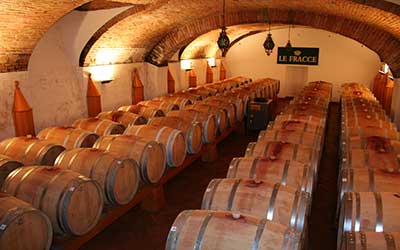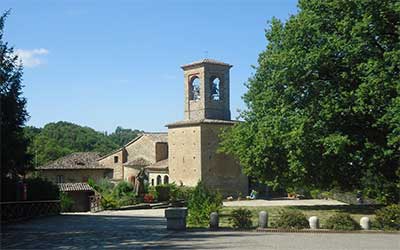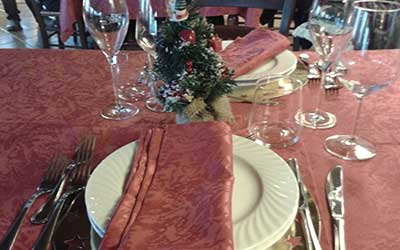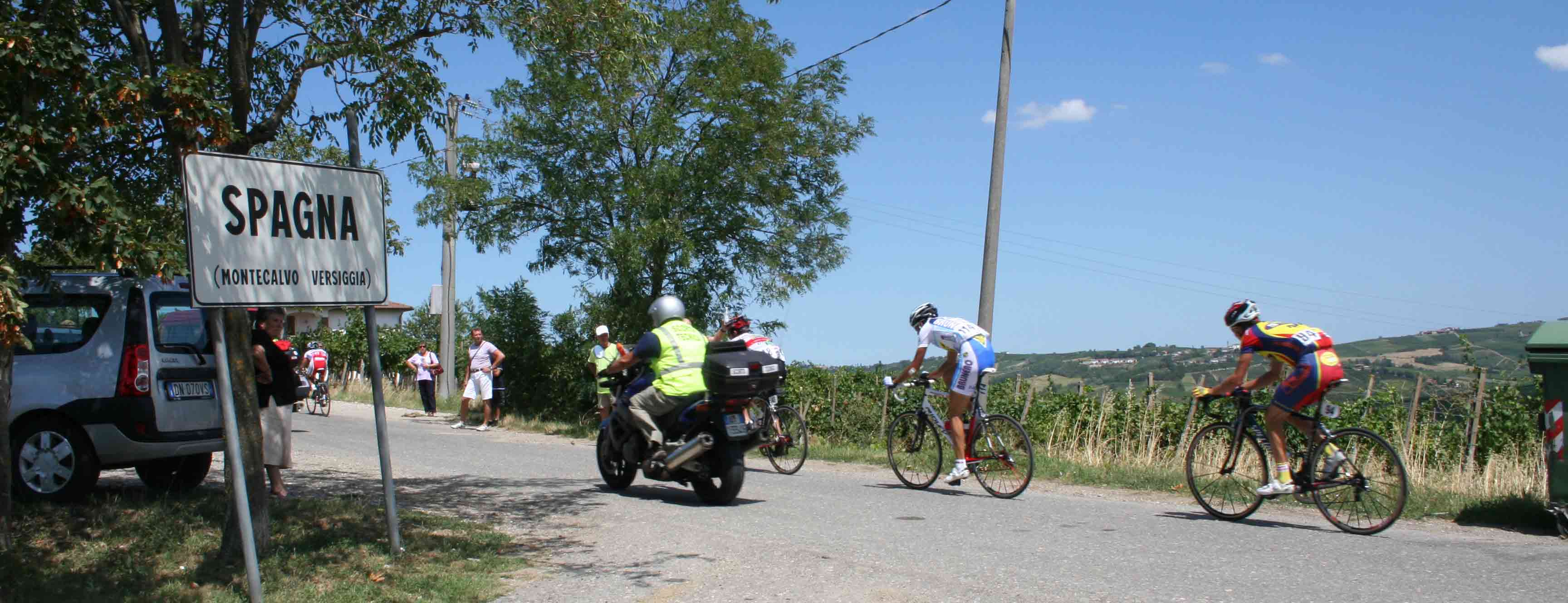Explore the Oltrepò Pavese
Welcome in the Oltrepò Pavese. A region not yet known to many tourists but certainly worth a visit because it offers a lot to those who like beautiful scenery, culture, tradional food, wine and other delicacies, and a reception by a friendly population.(Please note that this site is still under construction!)
Un undiscovered “Tuscan” landscape
Just an hours drive from Milan and only 30km of Pavia, at the foothills of the Apennines, the Oltrepò Pavese stretches out her vineyards, woods and meadows. A landscape reminiscent of Tuscany, with smooth hills, medieval castles, ancient villages and panoramic views.
Though being the largest wine producing region of Lombardy and one of the largest of the whole of Italy, the name Oltrepò Pavese hardly rings a bell with anyone. It is still undiscovered territory, tranquil and traditional, as if time has forgotten to touch this area.
The Oltrepò Pavese may easily (and should) be visited on a daytrip from Milan, for example on a Sunday, when restaurants in the big city are closed, whereas in the countryside the traditional Sunday lunch, il pranzo della domenica, is served. An experience not to be missed!

Local winesThe Oltrepò, home of the pinot nero grape
The Oltrepò happens to be the largest wine-producing area of Lombardy and one of the largest in Italy, especially of the Pinot Nero.

Discover the regionStay a few days and experience the Oltrepò
Hiking, cycling or a tour by car you will find unexpected points of interest, and you will certainly meet hospitable local people.

Culinary delightsEnjoy fine dining or the real cucina casalinga
The Italians are often convinced that their kitchen is the best in the world. It is always very tasty, especially in an area such as the Oltrepò,
Some statistics on the Oltrepò Pavese
Surface area
Municipalities
Inhabitants
Wine growers
A bit of history

San Colombano

Frederick Barbarossa,
the Holy Roman Emperor
After the Longobard rule in North Italy (568-774 aC) most of the territory of the Oltrepò fell under the jurisdiction of the monastery of San Colombano of Bobbio. San Colombano was one of the Irish monks and missionaries that christened the north western part of Europe in the 6th century. The journey of San Colombano from Ireland ended in Bobbio (which now lies in the province of Piacenza) where he founded his monastery. With the decline of the monastery rule began a period of the many feudal rulers, who were subject to the authority of the Holy Roman Emperor, or to the Bishop of Tortona.
The name Oltrepò Pavese is for the first time mentioned in a official document from 1164 aC signed by the Emperor Frederick Barbarossa, in which he granted the citizens of Pavia the right to rule the communities in an area which is now more or less the province of Pavia.
From 1359 Pavia and and the local feudal lords in the Oltrepò fell under the rule of the Dukes of Milan, first the Visconti family and later those of the Sforza’s.
In the beginning of the Napoleonic period (1786) the local feudal Lords lost their control of their posessions in the Oltrepò and the area became part of a newly created French 'departement' Marenga.
After the defeat of Napoleon (1814) the Oltrepò was part of the Kingdom of Savoie (the present Region of Piedmond), but after the unification of Italy (1861) the control of the Oltrepò was returned to the Region of Lombardy and became part of the province of Pavia. In 1923 the boundaries of the territory of the Oltrepò were finalized with the transfer of the aerea around Bobbio to the province of Piacenza.

Giavanni Visconte

Victor Emmanuel II,
the first king of a united Italy
Explore the Oltrepò
The best way to discover the Oltrepò is of course to stay a few days and tour around by bike or car and visit some of the sights, for instance the monastery of San Alberto di Butrio, the city of Varzi, Zavatarello and it's castle, or Bobbio with its medieval bridge and cloister of San Colombano.
Or put on your hiking shoes and follow one of the mainy trails through the nature reserve of Mont Alpe in Val Staffora and around Monte Pennice, of follow the footsteps of medieval salt traders on the Via del Sale or the Via degli Abati. You' ll be surprised by how tranquil the Oltrepò is, and impressed by the spectacular panoramic views along the way, such as from Cigognola with its castle. On a clear day you can sse the mountain range of the Alps in the north.
And don't forget to visit one of the more than 150 cantina’s to taste some of the wines that are typical of this region: Bonarda, Barbera, Buttafuoco, Sangue di Giuda, Pinot Nero, Riesling and the sparkling spumante's.
Hiking
The Oltrepò offers enough to entertain you. One of the nicest and most relaxing activities is to go hiking through the vineyards. You're free to walk through all the vineyards, people put up fences only around their houses. Nobody will be surprised and stare at you if they see you strolling among their vines. On the contrary, they will greet you friendly and start a conversation.
You will enjoy the tranquility, the magnificent views and the lovely weather. Sometimes the sky is so clear that you can see from the top of the hills the mountain range of the Alpes 150 km away!
Here you will find a list of itineries for walks.
Since a few years there exist also a described and signposted route from Pavia via Bobbio (Emilia-Romagna) to Pontremoli in Tuscany, the Via degli Abati. See also the website for this long distance hiking trail.
Cycling
Italians love race cycling. For the passionate cyclists and mountain bikers this area is ideal and challenging. There are several interesting websites which offer suitable and well-described cycle routes (road & MTB) in the Oltrepò:
A nice overview of the tracks in the Oltrepò can be found on this site. An Italian-English brochure on cycling in the plains of the river Po, north of the Oltrepò, can be downloaded here
Of course, you can also make short trips by car. The roads are not busy. En route, hiking, cycling, or by car, you can hardly miss the many bars, restaurants, trattorias or what else there is to cater for the hungry and thirsty. Many wine farms offer the opportunity to taste the local wines: a "degustazione". You should definitely try it!


Explore the Oltrepò
In the Oltrepò Pavese, the foothills of the Ligurian Alps are covered with small villages, hamlets, castles and forests. From the flood plain of the Po the hills gradually rise to a maximum height of 1700 meter Monte Lesima. Going around in this landscape provides you with stunning views. If you are not in a hurry you can explore the region by for instance visiting:
- Santa Maria della Versa, a centre of viniculture with its lively evening market each Thursday during the summer months July and August
- the historical city of Varzi, famous for its hand-made 'salami' sausages
- Zavatarello, with its medieval castle (open to the public on sundays)
- the beautifully restored "borgo" of Fortunago
- Salice Terme, a traditional spa with medicinal waters
- the small but charming abbey of Sant’Alberto di Butrio in Val di Nizza, with a number of beautiful medieval frescos
- the castles of Oramala and Montesegale
- the peak of Pietra Corva and its surroundings including the botanical garden with a collection of alpine plants
- the area around the small ski-resort Brallo di Pregola/Pian del Poggio
- the Penice Pass on the road between Varzi and Bobbio
The plains south of the Po are an integral part of the Oltrepò. Still on these plains there are several small cities such as Stradella, Broni, Casteggio and Voghera where you can find most of the shops and markets. Just next to the Oltrepò Pavese lies the province of Piacenza with its own character. Here you can visit many medieval castles, and the city of Bobbio known as the cultural center of the hills of the Piacentina region.
More info on the different sights you can find in the section cities & sights.
Day trips
The Oltrepò Pavese is centrally located in Northern Italy, making it possible to visit within one day one of the larger cities, the great lakes in the north or even the Mediterranian sea.
For a day out in the city, Pavia is the first choice with respect to location of the Oltrepò. Pavia is a charming, and historic city with a good mixture of sights (don't miss the old university buildings!) and shops. Of course there are plenty of restaurants and bars, for instance in its central square, Piazza Vittoria with its many terraces. There are a few must-see sights in the vicinity of Pavia: the monastry of Certosa di Pavia, and the beautiful Renaissance-square of Vigevano.
Further away but still within a two-hours driving distance lie the cities of Genoa, Turin, Bergamo, Parma, Cremona and Piacenza.
A visitor to Lombardy really cannot miss its capital. Milan is not only the seat of the regional government and the financial capital of Italy, but is also a bustling city full of energy where you can shop your heart out. There are lots of museums and monuments worth visiting.
You can read more about what to do in this metropole in the special Milan site.

The castle of Montesegale

The covered bridge in Pavia







